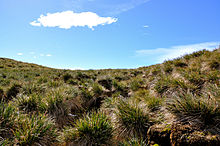Tussac grass
| Poa flabellata | |
|---|---|
 |
|
| Scientific classification | |
| Kingdom: | Plantae |
| (unranked): | Angiosperms |
| (unranked): | Monocots |
| (unranked): | Commelinids |
| Order: | Poales |
| Family: | Poaceae |
| Genus: | Poa |
| Species: | P. flabellata |
| Binomial name | |
|
Poa flabellata (Lam.) Hook. f. |
|
| Synonyms | |
|
|
Poa flabellata, commonly known as tussac grass or just tussac, is a tussock grass native to southern South America, the Falkland Islands, South Georgia and other islands in the South Atlantic. There are also 2 isolated records from the herbarium at the French Muséum national d'histoire naturelle for the Île Amsterdam in the Indian Ocean.
It was introduced to the Shetlands,Scotland for basket making in 1844, and possibly as a source of fodder because of its ability to grow in hostile conditions..
It grows in dense clumps, usually about 2 metres (6 ft 7 in) high (although they can be much taller), on wet coastal land and is a dominant feature of much of the landscape.
The plant community dominated by P. flabellata is widely used by birds and mammals.
Breeding colonies of southern fur seal, elephant seal, Magellanic penguin, macaroni penguin, and albatrosses are all found amongst tussac grass on South Georgia and elsewhere. The austral thrush is predominantly found in this habitat on the Falkland Islands, with tussocks being used as nesting sites. The South Georgia pipit also uses the tussocks for nesting.
On South Georgia, it is a principal food of the introduced reindeer, which has caused considerable environmental damage, including erosion and replacement of tussac grass by the introduced annual meadow-grass.
...
Wikipedia
